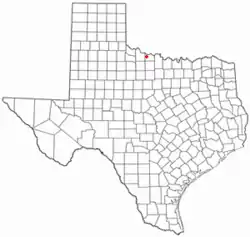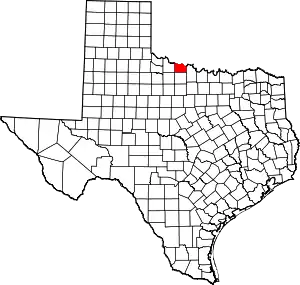Electra, Texas | |
|---|---|
_-_Liberty_Theater%252C_Electra%252C_Texas.jpg.webp) Liberty Theater, Electra, showing a Mary Pickford movie in 1919. | |
| Motto: "Wichita County's Best Kept Secret" | |
 Location of Electra, Texas | |
 | |
| Coordinates: 34°01′57″N 98°55′12″W / 34.03250°N 98.92000°W | |
| Country | United States |
| State | Texas |
| County | Wichita |
| Area | |
| • Total | 3.08 sq mi (7.98 km2) |
| • Land | 3.08 sq mi (7.97 km2) |
| • Water | 0.00 sq mi (0.01 km2) |
| Elevation | 1,227 ft (374 m) |
| Population (2010) | |
| • Total | 2,791 |
| • Estimate (2019)[3] | 2,730 |
| • Density | 887.23/sq mi (342.54/km2) |
| Time zone | UTC-6 (Central (CST)) |
| • Summer (DST) | UTC-5 (CDT) |
| ZIP code | 76360 |
| Area code | 940 |
| FIPS code | 48-22984[4] |
| GNIS feature ID | 2410419[2] |
| Website | www |
.jpg.webp)
Electra is a city in Wichita County, Texas, United States. It is part of the Wichita Falls metropolitan statistical area. The population was 2,791 at the 2010 census.,[5] down from 3,168 in 2000. Electra claims the title of Pump Jack Capital of Texas, a title made official by the state in 2001,[6] and has celebrated an annual Pump Jack Festival since 2002.[7] It was named in honor of Electra Waggoner, an heiress to the Waggoner Ranch.[8] Electra is also known for its Grand Theatre which was refurbished and now a functioning theater.
History
Daniel Waggoner started a ranch in present-day Electra in 1852. Around 30 years later, the Fort Worth and Denver Railway was built, and its railroad tracks ran through the area. In 1885, Waggoner's son, William Thomas Waggoner, successfully lobbied railroad executives to build a railroad station at the site. By this time, the Waggoner ranch covered a half-million acres. Until this time, the town was called Waggoner, but following the building of the station and a post office in 1889, it was dubbed Beaver Switch, after the nearby Beaver Creek. The opening of 56,000 acres (230 km2) of land north of the railroad station brought more farmers to the area. The town was renamed again in 1907, this time after Waggoner's daughter, Electra Waggoner.
Water can be scarce in this region of Texas, so Waggoner started drilling for water for the town's new residents. Most of these drilling sites were befouled by crude oil, which made the water unfit for drinking. Three years later, a developer from Fort Worth named Solomon Williams bought the land from Waggoner. Soon thereafter, he annexed nearby land, subdivided the land, and placed advertisements in national media trying to increase the population. His efforts were successful, and the town grew from a population of 500 to 1,000 between 1907 and 1910. The Waggoner family still owns much of the same land they did in the beginning and still drills for oil there.
In 1911, the Electra Independent School District was created.
On 1 April 1911, the Clayco Oil gusher brought in an oil strike at a depth of 1,600 feet (490 m), producing 260 barrels of oil per day (BOPD). Word spread quickly, and the population increased to over 1,000, with many more oil workers commuting from Wichita Falls. The town soon had brick buildings, cement sidewalks, and a telephone exchange.[9]
In 1936, Electra had well over 6,000 residents, but by the 1960s, the population had decreased to just over 5,000. The Dallas-Fort Worth Metroplex was growing, and many people moved away. By 2000, Electra's population had fallen to about 3,000.
Geography
Electra is located at 34°1′51″N 98°55′2″W / 34.03083°N 98.91722°W (34.030809, –98.917281).[10] According to the United States Census Bureau, the city has a total area of 2.4 mi2 (6.3 km2), all land.
Demographics
| Census | Pop. | Note | %± |
|---|---|---|---|
| 1910 | 640 | — | |
| 1920 | 4,744 | 641.3% | |
| 1930 | 6,712 | 41.5% | |
| 1940 | 5,588 | −16.7% | |
| 1950 | 4,970 | −11.1% | |
| 1960 | 4,759 | −4.2% | |
| 1970 | 3,895 | −18.2% | |
| 1980 | 3,755 | −3.6% | |
| 1990 | 3,113 | −17.1% | |
| 2000 | 3,168 | 1.8% | |
| 2010 | 2,791 | −11.9% | |
| 2019 (est.) | 2,730 | [3] | −2.2% |
| U.S. Decennial Census[11] | |||
| Race | Number | Percentage |
|---|---|---|
| White (NH) | 1,722 | 75.13% |
| Black or African American (NH) | 114 | 4.97% |
| Native American or Alaska Native (NH) | 12 | 0.52% |
| Asian (NH) | 11 | 0.48% |
| Some Other Race (NH) | 5 | 0.22% |
| Mixed/Multi-Racial (NH) | 119 | 5.19% |
| Hispanic or Latino | 309 | 13.48% |
| Total | 2,292 |
As of the 2020 United States census, there were 2,292 people, 1,253 households, and 606 families residing in the city.
Education
The City of Electra is served by the Electra Independent School District, which is composed of 210 sq mi (540 km2).
The three public schools are: B.M. Dinsmore Elementary School, with 225 students enrolled in prekindergarten through fourth grade; Electra Junior High with 172 students in grades five through eight; and Electra High School with 149 students enrolled in ninth through 12th grades. Electra High School's athletic teams are called the Tigers. The student/teacher ratio at each of the schools is 14:1, 13:1, and 9:1, respectively.
Notable Persons
- Ace Reid, an artist and humorist, grew up and lived in Electra until 1943, when he joined the Navy[15]
- Robert Craighead,[16] an award-winning actor, writer, producer, and country music musician who played Brok, the foul-mouthed blacksmith in God of War Ragnarok and Sheriff Walker Conley in Tyler Perry's Ruthless.
Climate
The climate in this area is characterized by hot, humid summers and generally mild to cool winters. According to the Köppen climate classification system, Electra has a humid subtropical climate, Cfa on climate maps.[17]
Utilities
- Telephone and Internet is provided by Hilliary Communications.
References
- ↑ "2019 U.S. Gazetteer Files". United States Census Bureau. Retrieved August 7, 2020.
- 1 2 U.S. Geological Survey Geographic Names Information System: Electra, Texas
- 1 2 "Population and Housing Unit Estimates". United States Census Bureau. May 24, 2020. Retrieved May 27, 2020.
- ↑ "U.S. Census website". United States Census Bureau. Retrieved January 31, 2008.
- ↑ "Population and Housing Unit Counts, 2010 Census of Population and Housing" (PDF). Texas: 2010. Retrieved January 5, 2017.
- ↑ Bernadette Pruitt."A fading town's liquid legacy: Once-thriving Electra hopes 'Pump Jack' title brings new fortune," The Dallas Morning News, September 23, 2001. Retrieved December 30, 2007.
- ↑ First Pump Jack Festival, photographs of the April 20, 2002, festival. Retrieved December 30, 2007.
- ↑ "Waggoner Ranch: History". Archived from the original on October 25, 2016. Retrieved March 13, 2018.
- ↑ Olien, Diana; Olien, Roger (2002). Oil in Texas, The Gusher Age, 1895-1945. Austin: University of Texas Press. p. 78. ISBN 0292760566.
- ↑ "US Gazetteer files: 2010, 2000, and 1990". United States Census Bureau. February 12, 2011. Retrieved April 23, 2011.
- ↑ "Census of Population and Housing". Census.gov. Retrieved June 4, 2015.
- ↑ "Explore Census Data". data.census.gov. Retrieved May 20, 2022.
- ↑ https://www.census.gov
- ↑ "About the Hispanic Population and its Origin". www.census.gov. Retrieved May 18, 2022.
- ↑
- Asa Elmer (Ace) Reid, Jr. (1925-1991) at Handbook of Texas OnLine]
- ↑
- ↑ "Electra, Texas Köppen Climate Classification (Weatherbase)". Weatherbase. Retrieved March 13, 2018.
Further reading
- 2006–2007 Academic Excellence Indicator System
- Adams, Jerry. Trade Token Tales: Electra Texas
- Electra, Texas. The Handbook of Texas Online
- Pruitt, Bernadette. A Fading Town's Liquid Legacy: Once-thriving Electra Hopes 'Pump Jack' Title Brings New Fortune. Dallas Morning News. 2001-09-23.
- Yates, John. Masonry in the Oil Patch: The First 75 Years of Electra Lodge No.1067 AF & AM. Electra Lodge No. 1067. 1988-06-25.
External links
- Electra Official Website
- Events in Electra, The Pump Jack Capital Association
- Electra ISD, Electra Independent School District
- Electra Hospital District
- Cowpokes Film Festival Official Website for Electra
